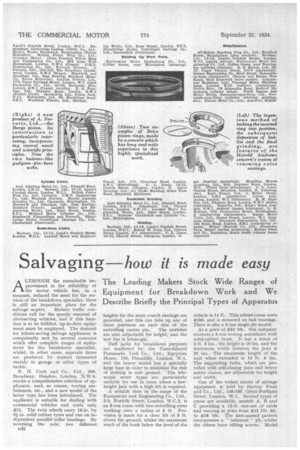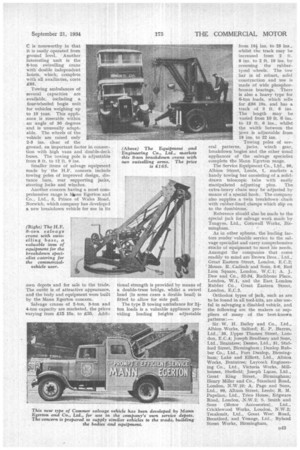Salvaging how it is made easy
Page 100

Page 101

If you've noticed an error in this article please click here to report it so we can fix it.
The Leading Makers Stock Wide Ranges of Equipment for Breakdown Work and We Describe Briefly the Principal Types of Apparatus
ALTHOUGH the remarkable improvement in the reliability of the motor vehicle has, in a measure, reduced the need for the services of the breakdown specialist, there is still an important place for the salvage expert. Modern traffic conditions call for the speedy' removal of obstructing vehicles, and if this function is to be fulfilled, up-to-date equipment must be employed. The demand for labour-saving salvage appliances is competently met by several concerns which offer complete ranges of equipment for the breakdown specialist, whilst, in other cases, separate items are produced by makers interested mainly in garage or other types of tackle.
R. I-1. Cook and Co., Ltd., 209, Broadway, Hendon, London, N.W.9, stocks a comprehensive selection of appliances, such as cranes, towing ambulances, etc., and a new model of the latter type has been introduced. The appliance is suitable for dealing with commercial vehicles and costs only £21. The twin wheels carry 16-in, by 3I-in, solid rubber tyres and run on independent parallel roller bearings. By reversing the axle, two different D42 heights for the main crutch carriage are provided, and this can take up any of three positions on each side of the swivelling centre pin.. The crutches are also adjustable for height, and the tow bar, is telescopic. .
Duff jacks for breakdown purposes are marketed by the Consolidated Pneumatic Tool Co., Ltd., Egyptian House, 170, Piccadilly, London, W.1, and the heavy model has a specially large base in order to minimize the risk of sinking in soft ground. The telescopic screw types are particularly suitable for use in cases where a low. heightjack with a high lift is required.
A notable item in the range of the Equipment and Engineering Co., Ltd., 2-3, Norfolk Street, London, W.C.2, is an 8-ton crane with two swivelling arms working over a radius of 5 ft. Provision is made for a clear lift of 8 ft. above the ground, whilst the maximum reach of the hook below the level of the
vehicle is 14 ft, This robust crane costs £165, and is mounted on ball bearings. There is also a 5-ton single-jib model.
At a price of £52 10s., this company markets a 5-ton-towing ambulance with solid-rubber tyres. It has a track of 3 ft. 6 ins., the height is 19 iris. and the maximum width between the jaws is 22 ins. The maximum length of the unit when extended is 13 ft. 6. ins. The supporting forks, which are provided with self-closing jaws and heavy safety chains, are adjustable for height and width. •
One of the widest stocks of salvage equipment is held by Harvey Frost and Co., Ltd., 148-150, Great Portland Street, London, W.1. Several 'types of crane are available, models A, B and C providing a 12-ft. run-out of cable and varying in price from £15 171. 6d. to £18 10s. The first-named pattern incorporates a " balanced " jib, whilst the others have tilting screws. Model
C is noteworthy in that it is easily operated from ground level. Another interesting unit is the 8-ton swivelling crane with double independent hoists, which, complete with all auxiliaries, costs £85.
Towing ambulances of several capacities are available, including a four-wheeled bogie unit for vehicles weighing up to 10 tons. This appliance is steerable within an angle of 30 degrees and is unusually adaptable. The wheels of the vehicle are raised only 2-3 ins, clear of the ground, an important factor in connection with high vans and 'double-deck buses. The towing pole is adjustable from 8 ft. to 12 .ft. 9 ins.
Smaller items of salvage equipment made by the H.F. concern include towing poles of improved design, distance bars, rear supporting jacks, steering locks and winches.
Another concern having a most comprehensive range is Wfwinn Egerton and Co., Ltd., 5, Prince of Wales Road, .Norwich, which company has developed a new breakdown vehicle for use in its own depots and for sale to the trade. The outfit is of attractive appearance, and the body and equipment were built by the Mann Egerton concern.
Salvage cranes of 2-ton, 3-ton and 4-ton capacity are marketed, the prices varying from £15 15s. to £35. Addi tional strength is provided by means of a double-truss bridge, whilst a swivel head (in some cases a double head) is fitted to allow for side pull.
The type B towing ambulance for 21ton loads is a valuable appliance providing loading heights adjustable from l6/ ins. to 25 ins., whilst the track may be increased from 2 ft. 8 ins. to 2 ft. 10 ins, by reversing the rubbertyred wheels, The tow bar is of robust, solid construction and use is made of wide phosphorbronze bearings. There is also a heavy type for 0-ton loads, which sells for £56 10s. and has a track of 3 ft. 6 ins. The length may be varied from 10 ft. 6 ins. to 13 ft. 6 ins., whilst the width between the -jaws is adjustable from 18 ins. to 22 ins.
Towing poles of several patterns, jacks, winch gear, breakdown bogies and the other usual appliances of the salvage specialist complete the Mann Egerton range.
• The Service Equipment Co., Ltd., 99, Albion Street, Leeds, I, markets a handy towing bar consisting of a soliddrawn telescopic tube with easily manipulated adjusting pins. The extra-heavy chain may be adjusted by means of a special hook. The company also supplies a twin breakdown chain with rubber-lined clamps which slip on to the dumbirons.
Reference should also be made to the special jack for salvage work made by Tangyes, Ltd., Cornwall Works, Birmingham.
As in other spheres, the leading fac
tors rendervaluable service to the salvage specialist and carry comprehensive stocks of equipment to meet his needs. Amongst the companies that come readily to mind are Brown Bros„ Ltd., Great Eastern Street, London, E.C.2; Messrs. R. Cadisch-.and Sons, 5-6, Red Lion Square, London, W.C.1; A. J. Dew and Co., 32-34, Rathbone Place, London, W.1, and the East London Rubber Co., Great Eastern Street, London, E.C.2.
Orthodox types of jack, such as are
to be found in all tool-kits, are also useful in salvaging a disabled vehicle, and the following are the makers or suppliers of many of the best-known .patterns :—
Sir W. H. Bailey and Co., Ltd.,
Albion Works, Salford; E. P. Banns, Ltd., 35, Kpper Thames. Street, London, E.C.4; Joseph Bradbury and Sons, Ltd., Braintree; Destro, Ltd., 31, Stafford Street, Birmingham ; Dunlop Rubber Co., Ltd„ Fort Dunlop, Birmingham; Lake and Elliott. Ltd., Albion Works, Braintree; Layeock Engineering Co., Ltd., Victoria Works, Millhouses, Sheffield; Joseph Lucas, Ltd., Great King Street, Birmingham; Henry Miller and Co., Standard Road, London, N.W.10; A. Page and Sons, Ltd., 99, Albion Street, Leeds; R. M. Papelian, Ltd., Trico House, Edgware Road, London, -N.W.2; S. Smith and Sons (Motor 'Accessories), Ltd., Cricklewood. Works, London, N.W.2; Tecalemit, Ltd., Great West Road, Breniford, and Youngs, Ltd., Ryland Street Works, Birmingham.








































































































































































